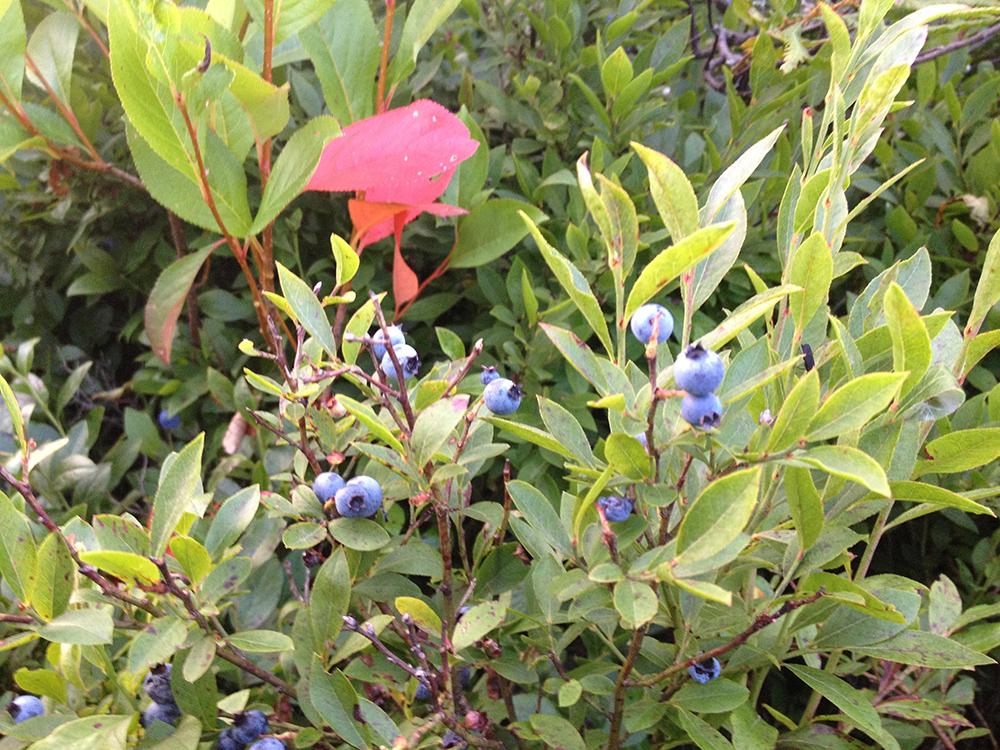
I would cheerfully walk for 10 miles if sun-warmed, wild blueberries were at the end of the trail. Fortunately, in New Hampshire we don’t have to walk that far, but it helps if we walk in an upwards direction. If we’re willing to wander up a mountain this time of year, we’re likely to find handfuls of juicy blue wonders, what our neighbors to the northeast like to claim as “the caviar of Maine” but what we like to just call “yummy.”
Old fields, island edges and roadsides are all good places to forage for wild blueberries, but mountaintops offer summer’s best two-fer: a great view and a healthful snack you don’t have to carry in your pack. Summits, the ones mostly barren of shade trees, offer just the kind of rotten conditions the wild blueberry covets.
You’ve got to admire this tough little plant.
It loves acidic, gravelly soil few other plants can take. It revels in relentless sun, all day long. Burn it to the ground and it comes back even stronger than before. Mow it to an inch high and it will thank you by sending out ever more abundant stems from its roots.

It’s just like the first Yankee farmers. How rugged they must have been! First they had to handsaw the forest to make fields. Then they had to heave rock after rock after rock to the side until they formed walls. Long walls that sometimes went up hillsides!
At least they had the kindred wild blueberry plants to give them something wonderful amidst all that work. As a native plant that also sustained Native Americans long before Yankee farmers, it’s been around a long time.
“The blueberry is a survivor,” summed up Bill Lord, a fruit specialist with the UNH Cooperative Extension. Lord has helped countless New Hampshire growers manage fields of wild blueberries for commercial harvest. Burning or mowing is a necessity to get strong yields, he says, because starting over stimulates more stems to sprout from underground rhizomes.
The rhizome actually holds 70 percent of the plant while only 30 percent grows above-ground. So actions that mimic natural forest fires or wildlife browsing also get rid of topside diseases and bushiness that might shade lower branches and squelch berry production.
About the only abuse that would stop wild blueberries is being paved over for a parking lot.
Toughness and deliciousness aren’t the only reasons to appreciate our wild blueberries. Their much-hyped “Wonder Fruit of the World” status couldn’t make them taste any better, but it’s another good reason to eat them whenever you can. Research shows the high antioxidant quality of blueberries that puts them at the top of the list of foods that may prevent cancer and other illnesses, and they contain resveratrol, the substance also found in red grape skins that may prevent heart disease.
Wild blueberry season in New Hampshire is typically around the end of July, sometimes starting mid-month and sometimes carrying over well into August, depending on conditions. This has been a very good blueberry year, according to Lord. “Great snow cover for winter protection, strong wild bee populations, limited frost during bloom, good soaking rains now.”
Earlier this week, my husband and I went in search of wild blueberries at the 431-acre Evelyn H. and Albert D. Morse Preserve in Alton. The property used to be managed as a commercial wild blueberry farm before the Morse family donated it to the Forest Society to be managed as a community treasure. Nowadays, our land management department arranges for a machine called a brontosaurus to mow the fields, located at the top of Pine Mountain, in order to keep the blueberries in production for wildlife and for visitors.
Looking out over Lake Winnipesaukee from the top and listening to two hermit thrushes sing their love song to each other was enough of a reward; adding blueberries seemed like an embarrassment of riches. That didn’t stop us from making a great outing even better!
Wild Blueberry Hikes
We found plenty of ripe berries last week on the Morse Preserve on Pine Mountain in Alton, but Pine is a relatively low mountain, and there weren’t more green berries on the bushes left to ripen. If you’d like to get out and enjoy wild blueberries, there’s still time, but try some higher summits:
Mt. Major and other Belknap Range mountains (Lakes Region)
Blue Job Mountain (Strafford)
Percy Peaks (Stark)
Gap Mountain (Jaffrey, Troy – see the Online Guide for this one at forestsociety.org)
Foss Mountain (Eaton)
Pitcher Mountain (Stoddard)
